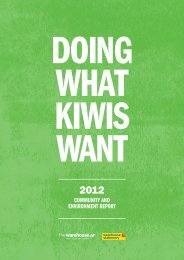ar11-lr-final
Create successful ePaper yourself
Turn your PDF publications into a flip-book with our unique Google optimized e-Paper software.
Notes to and forming part of the Financial Statements – continued<br />
For the 52 WEEK period ended 31 July 2011<br />
Notes to and forming part of the Financial Statements – continued<br />
For the 52 WEEK period ended 31 July 2011<br />
4. Financial Risk Management (CONTINUED) 4. Financial Risk Management (CONTINUED)<br />
(b) Market risk<br />
(i) Interest rate risk<br />
The Group’s exposure to market interest rates primarily relates to the Group’s core borrowings. The Group’s treasury policy is to<br />
manage its finance costs using a mix of fixed and floating rate debt. The Group’s policy is to maintain between 50% to 90% of core<br />
borrowings (repricing after twelve months) at fixed rates. At balance date 87% (2010: 86%) of the Group’s core borrowings were at<br />
fixed interest rates. The Group uses fixed rate debt and interest rate swaps to manage the fixed interest rate pricing and profile.<br />
The following sensitivity table, based on interest rate risk exposures in existence at balance date shows the effect of reasonably<br />
possible interest rate movements on after tax profit and equity, with all other variables held constant.<br />
GROUP<br />
Asset/(Liability)<br />
NotE<br />
CARRYING<br />
AMOUNT<br />
+100 BASIS POINTS -100 BASIS POINTS<br />
HIGHER/(LOWER)<br />
PROFIT<br />
EQUITY<br />
HIGHER/(LOWER)<br />
PROFIT<br />
EQUITY<br />
$000 $000 $000 $000 $000<br />
At 31 July 2011<br />
Cash and cash equivalents 18 23,016 166 166 (166) (166)<br />
Bank borrowings 29 (50,000) (360) (360) 360 360<br />
Fixed rate senior bond 29 (99,129) 571 571 (601) (601)<br />
Derivative financial instruments<br />
Interest rate swaps – cash flow hedges 22 (2,820) 360 (141) (360) (3,499)<br />
Interest rate swaps – fair value hedges 22 354 (571) (571) 601 601<br />
(128,579) 166 (335) (166) (3,305)<br />
At 1 August 2010<br />
Cash and cash equivalents 18 101,226 709 709 (709) (709)<br />
Bank borrowings 29 (75,000) (525) (525) 525 525<br />
Fixed rate senior bond 29 (98,642) 452 452 (490) (490)<br />
Derivative financial instruments<br />
Interest rate swaps – cash flow hedges 22 (3,210) 490 1,400 (490) (1,430)<br />
Interest rate swaps – fair value hedges 22 179 (452) (452) 490 490<br />
(75,447) 674 1,584 (674) (1,614)<br />
The parent has no exposure to interest rate risk, with the exception of its cash on hand at balance date.<br />
(ii) Foreign exchange risk<br />
The Group is exposed to foreign exchange risk arising from currency exposures, primarily with respect to the US dollar, through the<br />
purchases of inventory directly from overseas suppliers. The Group uses forward foreign exchange contracts to reduce the currency<br />
risks associated with these purchases.<br />
Management work to a Board approved Treasury Policy to manage foreign exchange risk. The policy parameters for hedging<br />
forecasted currency exposures are:<br />
• to hedge 40% to 100% of forecast US dollar commitments expected in the next 0 to 6 months<br />
• to hedge 0% to 85% of forecast US dollar commitments expected in the next 7 to 12 months<br />
• where exposures to other currencies arise, the Group hedges these risks once a firm commitment is in place<br />
• where foreign currency hedging extends beyond a 12 month time horizon, this requires the approval of the Group’s Chief Executive Officer.<br />
At balance date the Group had the following foreign currency risk exposures:<br />
GROUP CARRYING AMOUNT NOTIONAL AMOUNT<br />
Asset/(Liability) NotE 2011 2010 2011 2010<br />
$000 $000 $000 $000<br />
Forward currency contracts – cash flow hedges<br />
Buy US dollars/Sell New Zealand dollars 22 (30,867) (2,757) 252,382 175,812<br />
The average exchange rate of US dollar forward contracts at balance date were $0.7558 (2010: $0.7066). The spot rate used to<br />
determine the mark-to-market carrying value of the US dollar forward contracts at balance date was $0.8792 (2010: $0.7260).<br />
Throughout the year the Group’s US dollar hedge cover levels typically range between 55% to 70% of the forecast annual direct<br />
US dollar exposure. At balance date the Group has US dollar hedges in place to cover 73.0% (2010: 67.1%) of the forecast annual<br />
direct US dollar exposure. As a result of the US dollar exchange rate trading at historically high levels during the current year the<br />
Group has taken the unusual step of placing additional cover extending beyond 12 months. The additional cover represents 48.0%<br />
of the forecast 13 to 18 month direct US dollar exposure.<br />
The following sensitivity table, based on foreign currency risk exposures in existence at balance date, shows the effect of reasonably<br />
possible exchange rate movements on after tax profit and equity, with all other variables held constant.<br />
AFTER TAX PROFIT EQUITY<br />
GROUP HIGHER/(LOWER) HIGHER/(LOWER)<br />
Forward currency contracts – cash flow hedges 2011 2010 2011 2010<br />
$000 $000 $000 $000<br />
10% appreciation in the New Zealand dollar – – (14,162) (10,862)<br />
10% depreciation in the New Zealand dollar – – 17,309 13,276<br />
There is no profit and loss sensitivity, as the forward currency contracts have been designated as cash flow hedges and assumes<br />
they will be 100% hedge effective. The parent company has no currency risk exposures.<br />
(iii) Price risk<br />
Management work to a Board approved Treasury Policy to manage electricity commodity price risk. The Group manages its exposure<br />
to electricity price fluctuations by negotiating fixed price supply contracts with its electricity suppliers and using electricity pricing<br />
contracts (contracts for difference) to provide an economic hedge. The policy parameters for hedging forecast electricity price<br />
exposures are:<br />
• to hedge 60% to 100% of forecast electricity usage in the next 0 to 12 months<br />
• to hedge 0% to 75% of forecast electricity usage in the next 13 to 24 months<br />
• to hedge 0% to 50% of forecast electricity usage in the next 25 to 60 months<br />
At balance date the Group had the following electricity price risk exposures.<br />
GROUP CARRYING AMOUNT AVERAGE PRICE PER MWH NOTIONAL AMOUNT (MWH)<br />
ASSET/(LIABILITY) 2011 2010 2011 2010 2011 2010<br />
$000 $000 $ $<br />
Electricity pricing contracts – economic hedges – (194) – 82.64 – 14,688<br />
These contracts were fair valued by comparing the contract rate to the market rate for contracts with matching maturity periods.<br />
The Group’s “contracts for difference” did not qualify for hedge accounting and all movements in fair value have been recognised<br />
as an expense/revenue on the face of the income statement in the period they occurred. To reduce fair value earnings volatility<br />
the Group has not entered any new “contracts for difference” since 2008 and has now fully unwound all pre-existing “contracts for<br />
difference” preferring to use fixed price supply contracts to hedge the Group’s electricity price exposure.<br />
The parent has no direct exposure to commodity price risk.<br />
FINANCIAL STATEMENTS 44<br />
FINANCIAL STATEMENTS 45
















